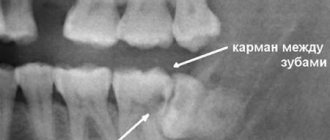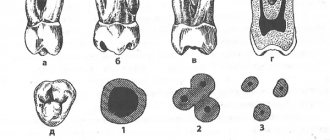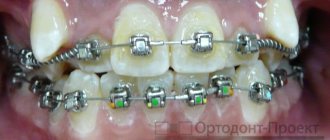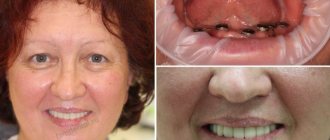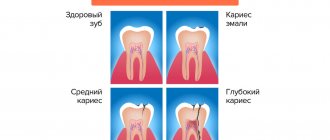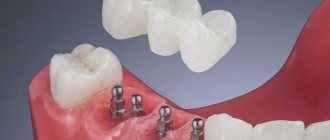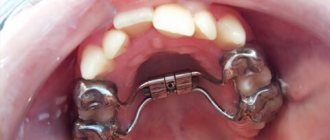03.02.2018
Caries is one of the most common dental diseases encountered in dentistry, and every person has encountered this problem at least once in their life. Naturally, there are people who have naturally healthy and strong teeth that do not require dental care. But every year there are fewer and fewer such people, and the reason for this is poor oral hygiene, bad habits, injuries and damage to teeth, and poor nutrition. Therefore, experts recommend that everyone go to the dentist 1-2 times a year, which will preserve the enamel and restore it at the initial stage of destruction.
Methods for treating caries
Dental treatment can be carried out in several ways:
- with preparation – the tooth cavity is cleared of affected areas;
- without preparation – no drill is used for treatment.
Dental treatment that does not involve preparation is an invasive and conservative method, suitable for the initial form of the disease.
Preparation is carried out in several stages:
- The oral cavity is prepared for the procedure; in some cases, teeth cleaning and removal of tartar or plaque are required.
- Depending on the complexity of the work, the specialist may use local anesthesia; in rare cases, general anesthesia is used.
- Next, the doctor begins to prepare the cavity formed by the carious process, the damaged tissue is removed, then the cavity is treated with special means. Such measures are necessary to prevent the growth of microbes, leading to the loss of the filling.
- A cavity is formed to hold the filling; for this, the dentist must give it a certain shape, which will prevent the filling compound from falling out. But most filling agents do not require such manipulations, since composites are able to chemically contact the tooth cavity.
- Isolation may require a special gasket, which is especially important in the treatment of deep caries, which helps protect the nerve from inflammation and microbes. The spacer prevents the composites from irritating the nerve of the tooth.
- Next, the filling composition is applied. To begin with, the dentist selects a shade, after which he isolates the diseased tooth with cotton swabs from other parts of the oral cavity and applies the material in layers.
Upon completion of the filling, the tooth is processed (polished and grinded), which not only makes it look natural, but also prevents tooth injury, discomfort and pain.
Sandwich technique on a chewing tooth [Clinical Example]
Patient T., 24 years old, came to the dental clinic with complaints of short-term pain from temperature stimuli in the area of the 4.7 tooth (Fig. 1). An objective examination of tooth 4.7 revealed a restoration that did not meet clinical requirements. Considering that the patient had a low level of caries resistance of hard dental tissues, as well as a significant cavity volume, the sandwich technique was chosen for treatment.
Rice. 1. Tooth 4.7: initial clinical situation.
Rice. 2. A gasket made of GIC “Ionofil Molyar” was applied.
Next, adhesive preparation of the cavity was carried out and its restoration was carried out using the nanohybrid composite “Grandio” (VOCO), which has reduced polymerization shrinkage, improved physical and mechanical characteristics and the highest color stability. Then the rubber dam was removed and the restoration was finished (Fig. 3).
Rice. 3. Tooth 4.7: final appearance after restoration.
Thus, due to the composite component, its aesthetic qualities have improved, the possibility of immediate finishing has become possible immediately after polymerization, the formation of a chemical bond with composites and very low solubility in water have been noted.
Unlike analogues, when working with Ionolux, there is no need for adhesive preparation of hard dental tissues (for example, there is no stage of priming of hard tissues), since it is a self-adhesive cement. It is well known that the more curing mechanisms a GIC has, the less fluoride ions it releases into surrounding tissues. However, in terms of the release of fluorine ions, Ionolux is not inferior to classical GIC.
Modern methods of caries treatment
Treatment of caries, dentistry offers more modern methods, subject to the initial and middle stages of the disease. They help stop the process of tooth decay and also help eliminate the cause.
The difference between modern methods of dental treatment is that the affected areas are removed without affecting healthy ones. In addition, the technologies do not include the use of boron; for this purpose, other methods of influencing areas affected by caries are used. The most popular methods are ozone, air-abrasive, infiltration and laser treatments. Such methods help not only to get rid of the disease, but also to prevent its occurrence.
If the patient has a deep stage of destruction, then treatment includes special modes of cleaning the tooth cavity with the application of a gasket under the filling material.
If it is possible to preserve the nerve, the specialist takes measures to prevent the recurrence of caries. These actions include:
- Taking into account the anatomical structure of the tooth, it is prepared with a bur.
- In order to prevent opening of the pulp chamber, the treatment of the carious cavity occurs with alternating low and high speeds of the tips.
- Caries detectors are used to identify carious areas.
- To protect the tooth from overheating, air-water cooling is used.
- Spacers are used to isolate the nerve of the tooth.
Treatment of caries involves more than one visit to the dentist, which will allow you to control the process of exposure to medications.
Sandwich technique
To achieve the most durable result when filling, several types of material are used at once, highlighting the positive aspects of each. Sandwich technology has a similar technique, it helps eliminate the disadvantages of many filling materials, such as bioincompatibility, shrinkage or deformation, for this purpose glass ionomer cements, as well as composites, amalgams and compomers are added to the filling material.
The application of gaskets made from these filling materials occurs in the following ways:
- open: the gasket covers one wall, there is contact with the oral environment;
- closed: there is no contact between the oral fluid and the edges of the cavity with the lining.
This filling technique allows:
- get rid of subgingival and cervical defects, in particular with carious destruction of the tooth root;
- stop the process of microbial proliferation;
- achieve naturalness due to the natural color of the filling;
- reduce shrinkage of filling material;
- The development of secondary caries is prevented due to the therapeutic effect of the lining.
Air abrasive method
The method is based on treating the damaged area with a sandblaster, which is used for professional cleaning of the oral cavity. During the procedure, mechanical treatment of teeth occurs by knocking out tissues destroyed by caries with a stream of air containing various impurities. Quartz sand was previously used as an admixture; later it was replaced with aluminum oxide, which does not change the color of the enamel and does not have a toxic effect. This method allows you to remove carious tissue without affecting healthy tissue. After such treatment, the risk of recurrent caries development is eliminated. The procedure is performed without anesthesia, is safe and painless, since there is no heating or vibration effect on the tooth. Air supply occurs in pulses of 6-10 seconds.
The disadvantage of the air-abrasive method is that it increases tooth sensitivity after the procedure; it is also not suitable for treating carious plaque in hard-to-reach places.
Infiltration
This method allows for dental treatment without the use of a drill. Indicated for caries caused by wearing braces or for removing carious lesions at the initial stage. A gel substance is applied to the affected surface, which can split part of the enamel. The tooth is dried with a stream of air and ethyl alcohol, after which the dentist treats it with a polymer resin.
One of the advantages of infiltration is that the procedure lasts no more than 20 minutes and there is no pain. It is worth noting that this method is only applicable to areas between the teeth and on the smooth surface of the teeth. A well-performed procedure will prevent the development of caries for many years to come.
Sandwich technique in dentistry
Sandwich technique is the use of amalgam, compomers, cements or composites with light-curing composite materials for the rapid and aesthetic restoration of a tooth destroyed by caries.
The application of these materials layer by layer resembles a “sandwich”, hence the name of the technique. It should be noted that this method has long been used all over the world and has proven itself well among both dental professionals and patients. All materials used are perfectly compatible with tooth tissues, have a cariesstatic effect, are resistant to various liquids and are quite durable. To restore large crowns of teeth, the dentist often turns to the method of closed or open sandwich technique . The choice between these two methods of crown restoration depends on numerous factors, in particular the location of the line of the gingival cavity (it can be at or below the gum level).
“Closed sandwich” method This option is often used by dentists to strengthen weakened walls and cusps of previously removed teeth, to restore deep cavities and large cavities.
“Closed sandwich” also involves the application of glass ionomer cement (abbreviated as GIC) in the form of a base thickened lining and covering it on all sides with a special composite material. In this case, the thickness of the composite from the occlusal and approximal surfaces should be equal to 2 mm. This technology is used in cavities of class 1 according to Black.
“Open sandwich” method In contrast to the above-mentioned option, the “open sandwich” method involves the use of glass ionomer cement in the form of a main thickened lining and covering it with a traditional composite material only from the occlusal surface and near the contact point. In this case, the gingival wall, which is made of glass ionomer cement with a height of about 2-3 mm, is not covered with a composite material. The “open sandwich” technique is considered relevant for cavities of class 5 according to Black.
Source
Treatment of caries without filling
There are a lot of ways to treat caries, but only some of them are able to remove the affected areas without filling. Such modern methods include:
ICON technology
One of the modern methods that allows you to get rid of the initial stage of caries. Indicated for patients who have had their braces removed, the method is similar to infiltration; during the procedure, a component is used on the affected area under the influence of an ultraviolet lamp, which helps eliminate carious spots. In this case, a polymer liquid gets into the damaged areas, helping to clog the pores.
Remineralization
The procedure allows you to stop the process of tooth destruction by filling the crystal lattice of the enamel with minerals. During the procedure, the surface of the tooth is coated with a product containing phosphorus, calcium and fluoride. The dentist also prescribes tablets containing fluoride, fluoridated salt and milk.
Ozone therapy
This method of caries treatment is common in pediatric dentistry for the purpose of bactericidal effects. Ozone therapy does not involve the use of preparation, anesthesia or filling. Ozone treatment takes place without injury, noise, pain or discomfort.
During the procedure, the damaged area is treated with a drug directed from a bowl, which converts oxygen into ozone. When ozone leaves the tooth, oxygen is converted again. During the treatment, bacteria that provoke the development of caries are destroyed, while healthy tissues are not affected; due to the high resistance to ozone, tooth tissues do not change or oxidize, and there is no development of an allergic reaction. Upon completion of the procedure, the surface of the teeth is coated with a special agent to restore the mineral composition. Ozone therapy is indicated for the initial stages of caries and for patients of any age; it helps prevent tooth decay. Due to the high cost, this method is used quite rarely.
Laser treatment
Laser treatment of caries does not require cavity preparation. Since carious tissue is soft, the laser is able to disinfect and remove caries-affected areas. Laser treatment is allowed during pregnancy, childhood, and also with increased tooth sensitivity. It is worth remembering that the procedure should only be performed by a qualified dentist, since incorrect actions can lead to damage to soft tissue.
It is worth noting that treatment of caries without filling is possible only at the initial stage of development of the disease, when carious spots appear and pain occurs.
Category Caries Posted by admin
Composites pros and cons
Currently, in most cases, composite materials are used for direct dental restoration. In cases with large restorations, the adhesion of the composite to the tooth enamel helps to re-strengthen its structure, unlike metal restorations, which do not have the same benefits. However, along with their advantages, they have a number of disadvantages: polymerization shrinkage and deformation of large-volume fillings over time, insufficient biocompatibility with hard dental tissues, lack of a cariesstatic effect, and high cost [3]. In addition, taking into account the peculiarities of the anatomical structure of dentin and its insufficient mineralization, composites are not recommended for use in children and adolescents (under 14 years of age).
When are dental fillings placed?
A filling is placed on a front or chewing tooth when it is necessary to reconstruct enamel and dentin damaged as a result of caries, non-carious destruction or trauma. In these cases, filling is advisable if no more than a third of the crown is lost - in the treatment of dental diseases and to improve the aesthetics of the dentition.
Sandwich technique using SDR™ in the restoration of the chewing group of teeth
It is no secret that one of the main indicators of a dentist’s work is the absence of complications after treatment and long-term positive results. However, when restoring teeth in the chewing group, ergonomics of work is also of considerable importance, since it is during the restoration of chewing teeth that, due to the volume of work, a large amount of time is spent.
There are many restoration techniques using composite materials. And all these methods of restoration of chewing teeth were created with the aim of minimizing the stress of polymerization shrinkage and the complications arising from it. Let's look at everything in order.

